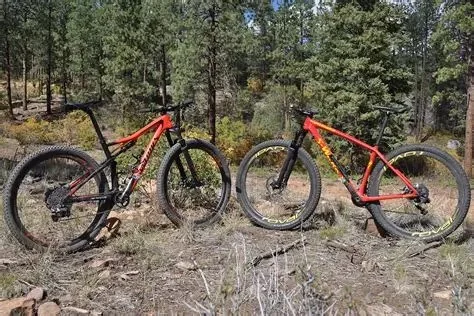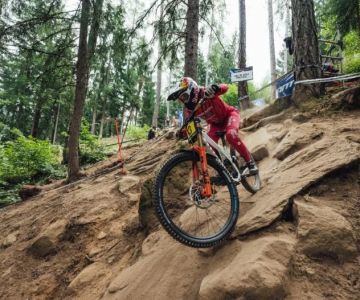
How to Choose Between Hardtail and Full Suspension
- 1. Understanding Hardtail Bikes
- 2. Understanding Full Suspension Bikes
- 3. Which Type of Bike is Right for You?
- 4. Advantages and Disadvantages of Each Type
- 5. Tips for Making the Final Decision
1. Understanding Hardtail Bikes
Hardtail bikes are known for their simplicity and lighter weight. A hardtail bike is a mountain bike that features front suspension but lacks rear suspension. The frame is typically rigid at the rear, providing a solid structure that allows for direct power transfer from the rider’s legs to the wheels. Hardtail bikes are ideal for riding on smoother trails and are often used for cross-country riding. Their design provides a more efficient pedaling experience, especially on flat terrain or when climbing.
2. Understanding Full Suspension Bikes
Full suspension bikes, also known as dual-suspension bikes, come with both front and rear suspension systems. The rear suspension is integrated into the frame, allowing for more control and comfort over rough terrain. These bikes are built to handle challenging trails, including rock gardens, technical descents, and root-filled paths. The added suspension helps absorb shock and reduces fatigue, providing a smoother ride and greater traction in difficult conditions.
3. Which Type of Bike is Right for You?
Choosing between a hardtail and a full suspension bike depends on your riding style, terrain preferences, and budget. Here are some key factors to consider:
- Riding Terrain: If you primarily ride on smooth, well-maintained trails, a hardtail bike may be the better option due to its efficiency and lower cost. For more technical or rugged terrain, a full suspension bike will provide a smoother, more controlled ride.
- Riding Style: Hardtail bikes are often preferred by cross-country riders who value speed and efficiency. Full suspension bikes are typically favored by downhill riders and those who enjoy trail and enduro riding.
- Budget: Hardtail bikes are usually more affordable than full suspension bikes due to the simpler design and fewer components. However, full suspension bikes offer greater comfort and control, which might justify the higher price for some riders.
4. Advantages and Disadvantages of Each Type
Here are the pros and cons of both bike types:
Hardtail Bikes
- Advantages:
- Lighter weight
- More efficient on smooth terrain
- More affordable
- Disadvantages:
- Less comfort and control on rough terrain
- Can be harder on the body during long rides
Full Suspension Bikes
- Advantages:
- Superior comfort and control on rough terrain
- Better for technical descents and challenging trails
- Helps reduce rider fatigue
- Disadvantages:
- Heavier than hardtail bikes
- More expensive due to the added suspension components
5. Tips for Making the Final Decision
Here are some final tips to help you make the best choice between hardtail and full suspension bikes:
- Consider your riding style: If you're a beginner or primarily ride on flatter terrain, a hardtail bike may be the right choice. If you're an advanced rider or frequently ride on technical terrain, a full suspension bike may be worth the investment.
- Try before you buy: Test ride both types of bikes to see which one feels more comfortable and suits your riding needs.
- Think about long-term comfort: If you're planning to ride for long hours or take on rough trails, the added comfort of a full suspension bike may be worth the extra cost.
- Factor in maintenance: Full suspension bikes require more maintenance due to the added complexity of the suspension system, while hardtail bikes are easier to maintain and repair.
Choosing the right bike is essential for enjoying your rides, and understanding the differences between hardtail and full suspension bikes will help ensure you make an informed decision. For more information on bike models and expert advice, visit Cycling Guider.







 Billet BMX5.0 (2 reviews)
Billet BMX5.0 (2 reviews) Far East Children Bicycle Factory1.0 (1 reviews)
Far East Children Bicycle Factory1.0 (1 reviews) Archer Motorsports, Inc.4.0 (8 reviews)
Archer Motorsports, Inc.4.0 (8 reviews) YEP Bike Works4.0 (55 reviews)
YEP Bike Works4.0 (55 reviews) Gorham Bike & Ski4.0 (498 reviews)
Gorham Bike & Ski4.0 (498 reviews) Alchemy Bikes4.0 (37 reviews)
Alchemy Bikes4.0 (37 reviews) How to Teach Kids to Ride a Bike: A Step-by-Step Guide for Parents
How to Teach Kids to Ride a Bike: A Step-by-Step Guide for Parents Tips for Riding on Busy City Streets: Smart Strategies for Urban Cyclists
Tips for Riding on Busy City Streets: Smart Strategies for Urban Cyclists Best US National Parks for Mountain Biking: Ride Epic Trails Across America
Best US National Parks for Mountain Biking: Ride Epic Trails Across America Best Aero Helmets for Time Trials and Racing
Best Aero Helmets for Time Trials and Racing How to Clean and Lubricate Your Bike Chain Like a Pro
How to Clean and Lubricate Your Bike Chain Like a Pro 10 Must-Have Items for Long-Distance Cycling Trips
10 Must-Have Items for Long-Distance Cycling Trips